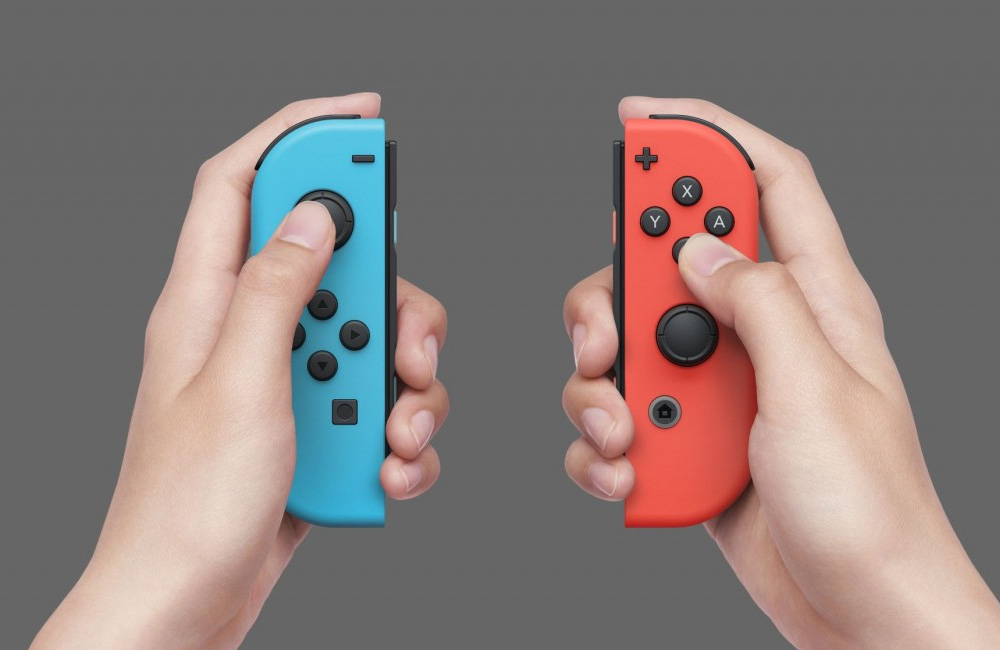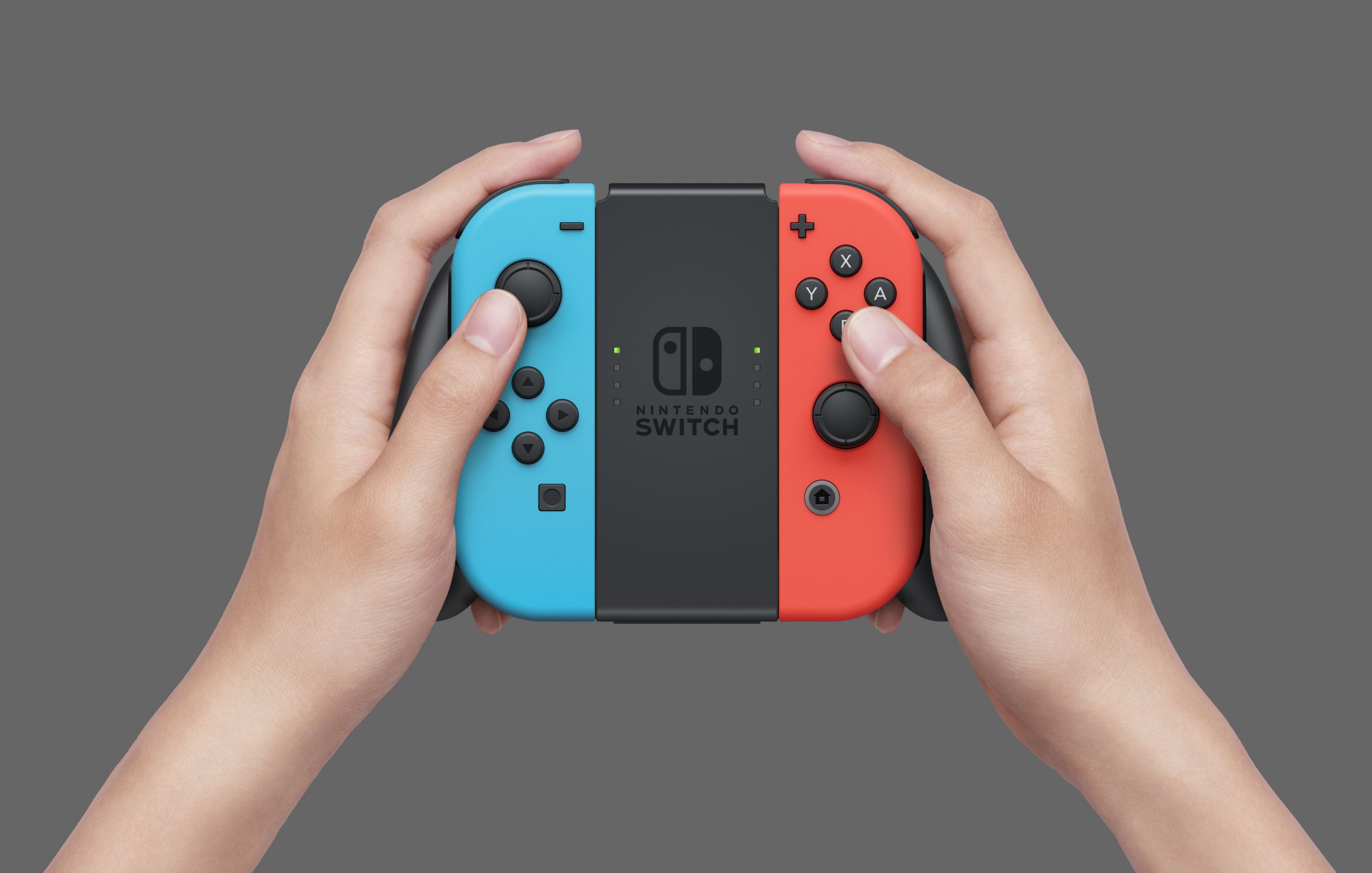In Part 1 of this series, I talked about my overall impressions of the Switch and it’s place in the spectrum of “home console” versus “handheld” gaming system. In this part I will focus more on the hardware and different “modes” of play, including the various ways the Joy Con can be used and the Pro Controller.
The real genius of the system is the Joy Con. They are deceptively versatile, and there are four distinct ways they can be used.
1. Connected Mode
What I’d call “connected mode” refers to playing the Switch with the Joy Con snapped onto either side of the system. This is most likely how you’d play the system when not docked. The Switch is effectively laid out the same as the Wii U’s GamePad in this mode, with some very minor differences in the locations of the various buttons.

The control sticks are a little more “handheld-ey” than the Wii U GamePad’s, which felt like the same kind that have been featured on Nintendo’s home consoles since they were first introduced with the N64. The Switch’s control sticks, by comparison, have a little less “action” and represent a halfway point between true control sticks and the “control dot” that Nintendo used on the various 3DS incarnations.
2. Disconnected Mode
You can also play with the Joy Con disconnected from the system, holding one in each hand. This feels similar to how it felt to use the Wii remote + Nunchuck combination on the original Wii. This is a surprisingly comfortable way to play.

Holding the Joy Con in your palms takes away some of the “too small” feeling that you can otherwise get while they’re connected if you have bigger hands like I do, since they fit snugly in your palms (note: the person in the photo above has very small hands). The sticks feel better when used this way, too, since you can hold the controllers at a more natural angle, the slightly limited range of motion of the sticks feels less noticeable.
I purchased the Pro Controller along with my Switch, but if I hadn’t I’d favor this mode for games like Zelda.
3. Grip Mode
The third “single player” mode for playing with both Joy Con as a unit is to use the “comfort grip” which is included with the console. This is effectively a plastic handle that the two Joy Con can be snapped onto (much like the sides of the console itself) with a little extra ergonomics to give them a more robust feel.

I haven’t played this way much, since I’ve mostly been using the Pro Controller when playing on the TV, but I think I prefer the disconnected mode anyway. The grip feels slightly flimsy, and it feels more natural to hold the Joy Con in your palms versus the angle the sticks wind up being at in the grip.
Note: There is also a “charging grip” accessory that Nintendo sells separately, which I would recommend against buying. It’s effectively the same as the “comfort grip,” except it has a USB-C connector on the bottom, meaning you can plug it in. It does not have it’s own battery installed, so it’s just a passive connection that only charges the controllers when plugged in. They charge whenever they’re connected to the Switch itself, so I’d recommend charging them that way when not in use and then using them disconnected or with the comfort grip. The only way the charging grip would make sense is for charging a second pair of Joy Con, but as of this writing I don’t think there are any games that support using more than two at a time anyway.
4. NES Mode
I’m sure “NES Mode” is not the official Nintendo-sanctioned nomenclature for this mode, but it’s the way I think of it intuitively. Similar to the way you could play NES games on the Wii’s Virtual Console by holding a Wii remote sideways, the Joy Con can be used as two separate controllers for multiplayer games. There are small plastic “grips” which can be attached in this mode to make the controllers a little more ergonomic when used horizontally.

Whether using the left or right Joy Con, this is actually quite comfortable. I actually find them to be more comfortable than the horizontal Wii remote was. They have the same button layout as the SNES controller in this mode, so it will obviate the need to purchase a separate controller for SNES games in the Virtual Console when it arrives.
The only problem I can forsee is that the aforementioned smaller control sticks on the Joy Con might make them less well suited for playing games that require precision, especially some of the classic NES or SNES twitch-based action games. I’ve really only used this mode for Snipperclips thus far, which is relatively slow paced. I think this mode will get a lot of action once Mario Kart is released.
The Pro Controller
I never bothered with the Pro Controller on the Wii or Wii U, as I found it totally fine playing with the Wiimote+Nunchuck combo on the former, and the GamePad on the latter.

However, I read some early reports that highly recommended the Pro Controller for the Switch for people with larger hands, especially for long sessions such as with Zelda. I picked one up mostly because I had the money from selling my Wii and Wii U burning a hole in my pocket while I waited for my pre-ordered Switch to arrive.
It’s a very good controller. I’d say of any controller I’ve ever used, it feels the most like the XBox 360 controller (I’ve never owned an XBox, but I bought a controller to use for the rare instances I wanted to play a PC game, like Portal and The Witness).
I’ve primarily been using it when playing Zelda on the TV. The one addition it has over the XBox 360 controller is the inclusion of motion controls, so you can still tilt the controller around for doing things like aiming your bow in Zelda, which is a lot more intuitive than trying to aim with a control stick (which I’ve always been horrible at in FPS games).
I would say that I’m not 100% sure that I’d buy one if I could go back in time, playing with one Joy Con in each hand is comfortable enough that I think I’d be totally fine playing Zelda that way if needed (though I’m not sure how the motion controls would work in that scheme, I assume you’d just tilt one or the other Joy Con but I don’t know which).
Still, that’s not to say that I have buyer’s remorse. It’s definitely the most hefty and heavy-duty controller available for the system, and comfortable for longer stretches. It’ll also be nice once games that support over 2 players start coming out, since someone can use the Pro Controller while two others use a Joy Con apiece (for Mario Kart, for example).
It’ll probably also be preferrable for Mario Odyssey, which I imagine will require much more precise controls for jumping and running than Zelda, where you can pretty easily get by with the Joy Con’s more limited control sticks.
